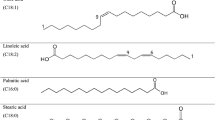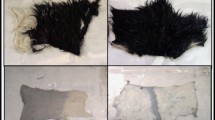Abstract
A conditioner containing lugworm autolysate was prepared, and its feasibility as a new conditioner was investigated. The treatment of hair with the conditioner, before and after dyeing showed positive effects on the thickness, weight, and amino acid contents of the hair. These properties were significantly enhanced, and similar results were obtained by hair surface examination by using scanning electron microscopy and tensile strength measurements. The surface of the cuticles in the experimental group was smoother than that of the control group, and the arrangement of the hair scales was maintained even after shampooing for 20 times. The hair tensile strength of the experimental group was significantly higher than that of the control group. The significant treatment effect of the conditioner containing lugworm autolysate could be attributed to the synergistic effect of adhesive strength and effective film formation properties of lugworm autolysate.
Similar content being viewed by others
References
J. Menkart, L. J. Wolfram, and I. Mao, J. Soc. Cosmet. Chem., 17, 769 (1966).
C. E. Reese and H. Eyring, Text. Res. J., 20, 743 (1950).
Y. K. Kamath, S. B. Hornby, and H. D. Weigman, J. Soc. Cosmet. Chem., 35, 21 (1984).
R. Wickett, J. Soc. Cosmet. Chem., 34, 301 (1983).
E. G. Bendit, J. Macromol. Sci. Phys., Part B, 17, 129 (1980).
W. Edman and M. Marti, J. Soc. Cosmet. Chem., 12, 133 (1961).
L. Wolfram, “The Reactivity of Human Hair: A Review, in Hair Research”, p.497, Springer Verlag, New York, 1981.
T. A. Evans, T. N. Ventura, and A. B. Wayne, J. Soc. Cosmet. Chem., 45, 279 (1994).
W. J. Choi, S. M. Kang, and J. Koh, Fiber. Polym., 13, 1058 (2012).
M. Yuta and Y. Yumika, U. S. Patent, 20060281994 (2006).
S. H. Suh, Journal of the Society of Cosmetic Scientists of Korea, 24, 128 (1998).
R. J. Stewart, C. S. Wang, and H. Shao, Adv. Colloid Interface Sci., 167, 85 (2011).
S. S. Lee and S. M. Kang, J. Korean Soc. Cosm., 17, 609 (2011).
R. W. Davis, D. C. Arango, H. D. Jones, M. H. Van Benthem, D. M. Haaland, S. M. Brozik, and M. B. Sinclair, J. Pept. Sci., 15, 511 (2009).
T. V. Ovchinnikova, G. M. Aleshina, S. V. Balandin, A. D. Krasnosdembskaya, M. L. Markelov, E. I. Frolova, Y. F. Leonova, A. A. Tagaev, E. G. Krasnodembsky, and V. N. Kokryakov, FEBS Lett., 577, 209 (2004).
M. Y. Lee and Y. K. Kim, Journal of Ecology and Field Biology, 21, 73 (1998).
S. E. Yoo and S. M. Kang, J. Korean Soc. Cosm., 16, 949 (2010).
H. K. Kim, Ph.D. Dissertaton, Kosin University, Korea, 2005.
M. N. Chandrashekara and C. Ranganathaiah, Colloids and Surfaces B: Biointerfaces, 69, 129 (2009).
C. R. Robins, “Chemical and Physical Behavior of Human Hair”, 4th ed., p.156, Springer-Verlag, New York, 2002.
D. H. Johnson, “Hair and Hair Care”, lst ed., p.167, Marcel Dekker, New York, 1997.
T. Inoue and M. Ito, J. Cosmet. Sci., 53, 337 (2002).
G. L. Taghon, F. G. Prahl, M. Sparrow, and C. M. Fuller, Marine Biology, 120, 287 (1994).
V. Wilkerson, J. Biol. Chem., 112, 329 (1935).
A. Kelch, S. Wessel, T. Will, U. Hintze, R. Wepf, and R. Wiesendanger, J. Microsc., 200, 179 (2000).
J. M. Choi, H. J. Na, S. J. Park, and J. H. Chang, Journal of the Korean Society of Fashion & Beauty, 3, 72 (2005).
A. N. Syed and H. Ayoub, Cosmetics & Toiletries Magazine, 117, 57 (2002).
P. Alexander, M. Fox, and R. Hudson, Biochem. J., 49, 129 (1951).
S. H. Kim, J. Korean Soc. Cosm., 11, 307 (2005).
M. Fernandes and C. Paulo, Biocatal. Biotransfor., 30, 10 (2012).
Author information
Authors and Affiliations
Corresponding author
Rights and permissions
About this article
Cite this article
Kwon, YJ., Koh, J., Lee, SS. et al. Conditioning effect of a hair conditioner containing lugworm autolysate. Fibers Polym 14, 2103–2110 (2013). https://doi.org/10.1007/s12221-013-2103-2
Received:
Revised:
Accepted:
Published:
Issue Date:
DOI: https://doi.org/10.1007/s12221-013-2103-2




